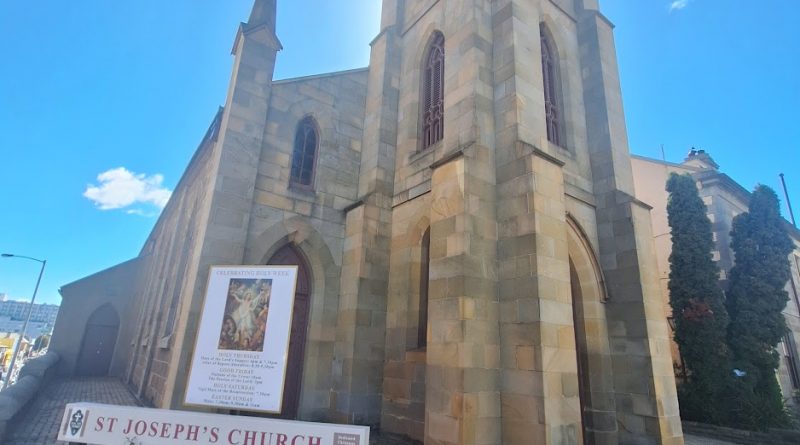Churches of the World
Tasmania
with
Joanne & Frank

Photo credit: Joanne & Frank
St. Joseph’s Catholic Church, Hobart Tasmania, Built – 1844
While riding in a taxi during our visit to Rome some years ago, we asked the driver about the number of churches in Rome. He replied in Italian, “A Roma, ci sono piu chiese che tasi.” In Rome there are more churches than taxies.” That’s incredible when you learn that there are five countries that have even more Christian churches per capita, than Italy.
It’s very interesting, when you think about it, just how many churches there are around the world. Christians alone for example, total somewhere around 2.18 billion members, in 37 million churches serving approximately that many congregations, worldwide. And that’s just Christian churches. When you take into consideration the non-Christian congregations around the world, the number of places of worship on earth is almost incomprehensible.
Think about how many people there were in each parish or congregation to be able to support that many religious communities; pretty incredible!
As we write this, Easter is around the corner, so Joanne and I thought it would be fascinating to visit as many churches as we could during the Passover season just for the experience.
So today, Palm Sunday in the Christian world, we thought we would begin to share what we have found by personally visiting churches, one by one – each with its own unique story and interesting history.
By the way, Joanne and I were raised Roman Catholic, and we respect every denomination that believes in Peace and Fairness. For now, however we are going to focus on Catholic churches before we go on and explore so many of the others.
Today and for this particular Easter Season we are in Tasmania. Hobart Tasmania to be exact. And we’ve chosen Saint Joseph’s Catholic Church in Hobart.

Photo credit: Joanne & Frank
Credit to Shirley King, 1991 for the following.
“St Joseph’s Church was built in 1841 and opened and blessed by Father Therry early on Christmas morning 1841.
The church is built of local sandstone and was designed by James Thomson, a former convict. Convict labourers were employed to carry out the work. The tower, 60 feet high, was finished in 1843 and the church building has not changed greatly since.
Photo credit: Joanne & Frank
In 1856 the sanctuary was improved, small sacristies behind the altar and a choir gallery above were removed and the present sacristies were built on the side of the church. The side chapel was built in 1877 as a choir for the Sisters of Charity, who lived from 1847 to 1957 in what is now the presbytery. During the 1930s the side chapel was replaced by the present red brick chapel, built by Jack Dunne. A small sandstone building, which had been used as a Sunday school for some years, was demolished at this time. Extensive restoration has been carried out during the past thirty-five years.
St Joseph’s is the oldest Catholic Church in Hobart and served as a cathedral while St Mary’s was being built. The first Bishop of Hobart, Robert William Willson was installed in St Joseph’s on 12 May 1844. The following year, he confirmed 500 people in the church.
The Church
The old altar is alabaster, delicately carved with scenes of the Annunciation and Nativity, with figures of Our Lady and St Joseph. The pillars are Irish Marble. It was made in London to a design by Douglas Salier of Hobart and installed in 1905 to replace the 1856 altar, which was wood painted blue and gold in medieval style. The present blackwood altar was made by Walter Nicholls in 1983, as was the President’s Chair and other blackwood refurbishments. He also made the large cabinet at the entry to the church in 1981 and the bookstand, both of old cedar from cedar pews dating from 1841, found in the gallery.

Photo credit: Joanne & Frank
The cedar pulpit was made in 1856 by Henry Hunter, architect in charge of the alterations. It was originally mounted on the wall above the sacristy door. It was later moved to a lower base and eventually placed on the far side in the sanctuary during the more recent renovations. The cedar bookstand was added in 1982. The large wooden crucifix also dates from 1856; the figure had been brought from Europe by Bishop Willson. It was supported by a rood screen, which was removed in 1959, except for the top and sides. The sanctuary walls were panelled in 1973 by Walter Nicholls, matching the design of the pulpit, but including the Passionist Emblem.

Photo credit: Joanne & Frank
The painting above the altar, “The Resurrection”, by Mather Brown, an American artist, was purchased in 1838 for the rented room used as a temporary chapel. In 1856, “Our Lady” and “St Joseph” by William Paul Dowling, an Irish political exile, were hung on either side. These paintings were removed on 4 September 2004 and taken to Melbourne for cleaning and restoration. They were reinstalled in the Church on 19 December 2005. Two large murals on the side walls of the sanctuary, “St Peter’s First Sermon” and “Feed My Sheep” were painted by Benjamin Sheppard. These were painted over in the 1930s but small sections have been rediscovered and hopefully will be restored as expertise and finance become available.
The old sanctuary lamp, given to St Joseph’s in 1971, was used in Sydney by the first bishop, John Bede Polding. The Stations of the Cross in painted terra cotta, were purchased by the parishioners from France and installed and blessed by Father Hilary O’Meara CP on 2 July 1893.





